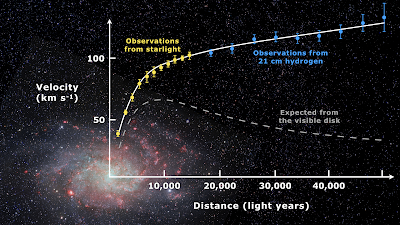Another question from my honorary Papou (Greek grandfather): As you
know I am very troubled by Dark Matter ..... it makes sense in my mind sometimes and sometimes not. [...] Somehow, for my understanding, Science needs a very convincing argument and some form of proof that Dark Matter exists. I read whatever comes before me about Dark Matter, it is a compelling theory. If I recall correctly did not Einstein use a "constant" to compensate for his calculations? Was that perhaps to compensate for Dark Matter?
know I am very troubled by Dark Matter ..... it makes sense in my mind sometimes and sometimes not. [...] Somehow, for my understanding, Science needs a very convincing argument and some form of proof that Dark Matter exists. I read whatever comes before me about Dark Matter, it is a compelling theory. If I recall correctly did not Einstein use a "constant" to compensate for his calculations? Was that perhaps to compensate for Dark Matter?
There are actually two forces in physics commonly referred to as "dark", dark matter and also dark energy. The use of dark in the names partly refers to the fact that we don't really understand them. Some observations, which I'll discuss in a moment, don't line up with our current theory of gravity, so dark matter and dark energy were added as a sort of question mark to fill in the gap. One target of the Large Hadron Collider (now that they've found the Higgs boson) is a dark matter candidate called a WIMP (weakly-interacting massive particle).
Dark Matter
My first physics class at Swarthmore was an overview of modern physics, covering special relativity, quantum mechanics, and cosmology. For the last topic, we were introduced to dark matter through the example of galactic rotation curves, which is how I plan to explain it today.
Imagine tying a weight to a piece of rope and swinging it in a circle. The rope pulls taut with a force related to the mass of the weight, m, the speed of its motion, v, and the length of the rope, r,
This is called the centripetal force, because it always points toward the center of the circle.
Based on the amount of light coming from distant galaxies, astronomers can estimate how much mass is contained in different parts of the disk. Via gravity, that mass provides the centripetal force that makes the galaxy rotate, so we can estimate how fast that rotation will be:
where M_enc is the total mass enclosed in radius r. Setting this equal to the rotation equation above gives a velocity ofThe trouble is, this doesn't line up with observations – Astronomers have found that galaxies spin significantly faster than the observed mass would imply.
 |
| Via Wikipedia |
This could be explained by the presence of extra matter that we can't see, hence "dark". Other models have been proposed that are based on space behaving differently at galactic-size scales, but so far none have surpassed the accuracy of assuming extra matter.
Dark Energy
Even using just the matter we see, Einstein calculated that the universe would eventually collapse from the gravitational pull. This disturbed him, since he expected to find a static universe, one that neither expands nor contracts. That led him to add a cosmological constant called Λ (capital lambda) to his equations, which provided a balancing force. Later observations by Hubble showed that the universe was in fact expanding, and accelerating in its rate of expansion! Based on observations from WMAP, a space telescope, scientists estimated the total energy content of the universe (remember E = mc^2):
 |
| Via Wikipedia |
In essence this says that we're not really sure what 95% of the universe is made of! Don't assume that means science is useless though: We can predict the behaviors of astronomical objects with stunning accuracy. All that's missing is an explanation for these behaviors. I always like to think of physics as successive approximations: We have a model that works extremely well, but after we learn a little more, we can make it that much better!



No comments:
Post a Comment